Recycling of Nonwoven Polyethylene Terephthalate Textile into Thermal and Acoustic Insulation for More Sustainable Buildings
Abstract
:1. Introduction
2. Materials and Methods
2.1. Nonwoven Polyester Waste Textile
2.2. Water Glass
2.3. Method and Process of Thermal Insulation Production
2.4. Experimental Methods
2.4.1. Thermal Conductivity Test
2.4.2. Reaction to Fire Test
2.4.3. Sound Absorption Test
3. Results and Discussion
3.1. Thermal Conductivity Coefficient λ
3.2. Fire Resistance Property
3.3. Acoustic Properties
3.4. Comparison of Developed Insulation Board with Conventional Insulation Materials
4. Conclusions
- Compact semi rigid thermal insulation boards can be produced with densities ranging from 123.2 to 255 kg/m3.
- Thermal conduction testing proved that the specimens without water glass and with the lowest density are suitable for the purpose of providing thermal efficiency in buildings and have thermal conductivity coefficient λ values of 0.044 W/(m·K). The addition of water glass during the production process had a negative impact on the thermal conductivity coefficient λ, which increased by 0.005 up to 0.049 W/(m·K).
- The reaction to the fire test has shown that the addition of water glass makes the product more vulnerable to open flame, which is in contradiction to the desired properties. At the same time, the specimens without water glass show a favorable self-extinguishing behavior when exposed to fire.
- All of the produced specimens have NRC of more than 0.20 and can therefore be classified as sound absorbing products. As expected, they show low sound absorption coefficient α within the low frequency range. NRC increases from 0.20 to 0.60 with the increasing density of the specimen without added water glass. The specimens with the highest density proved to have the sound absorption coefficient between 0.70 and 0.80 at 1 kHz and above.
Author Contributions
Funding
Institutional Review Board Statement
Informed Consent Statement
Data Availability Statement
Acknowledgments
Conflicts of Interest
References
- García-Granero, E.M.; Piedra-Muñoz, L.; Galdeano-Gómez, E. Eco-Innovation Measurement: A Review of Firm Performance Indicators. J. Clean. Prod. 2018, 191, 304–317. [Google Scholar] [CrossRef]
- European Commission. Secretariat-General Communication from the Commission—European Green Deal; Publication Office of the European Union: Luxembourg, 2019. [Google Scholar]
- Hojnik, J.; Ruzzier, M. What Drives Eco-Innovation? A Review of an Emerging Literature. Environ. Innov. Soc. Transit. 2016, 19, 31–41. [Google Scholar] [CrossRef]
- Directorate-General for Communication (European Commission). Circular Economy Action Plan: For a Cleaner and More Competitive Europe; Publications Office of the European Union: Luxembourg, 2020; ISBN 978-92-76-19070-7. [Google Scholar]
- Directorate-General for Environment (European Commission). Report from the Commission to the European Parliament, The Council, The European Economic and Social Committee and the Committee of the Regions on the Implementation of the Circular Economy Action Plan; Publications Office of the European Union: Luxembourg, 2019. [Google Scholar]
- European Commission. Communication from the Commission to the European Parliament, The Council, The European Economic and Social Committee and The Committee of The Regions Closing the Loop-An EU Action Plan for the Circular Economy; Publications Office of the European Union: Luxembourg, 2015. [Google Scholar]
- Dalhammar, C. Industry Attitudes towards Ecodesign Standards for Improved Resource Efficiency. J. Clean. Prod. 2016, 123, 155–166. [Google Scholar] [CrossRef]
- Marcon, A.; de Medeiros, J.F.; Ribeiro, J.L.D. Innovation and Environmentally Sustainable Economy: Identifying the Best Practices Developed by Multinationals in Brazil. J. Clean. Prod. 2017, 160, 83–97. [Google Scholar] [CrossRef]
- Briga-Sá, A.; Nascimento, D.; Teixeira, N.; Pinto, J.; Caldeira, F.; Varum, H.; Paiva, A. Textile Waste as an Alternative Thermal Insulation Building Material Solution. Constr. Build. Mater. 2013, 38, 155–160. [Google Scholar] [CrossRef]
- Binici, H.; Eken, M.; Dolaz, M.; Aksogan, O.; Kara, M. An Environmentally Friendly Thermal Insulation Material from Sunflower Stalk, Textile Waste and Stubble Fibres. Constr. Build. Mater. 2014, 51, 24–33. [Google Scholar] [CrossRef]
- Valverde, I.C.; Castilla, L.H.; Nuñez, D.F.; Rodriguez-Senín, E.; de la Mano Ferreira, R. Development of New Insulation Panels Based on Textile Recycled Fibers. Waste Biomass Valorization 2013, 4, 139–146. [Google Scholar] [CrossRef]
- Quartinello, F.; Vecchiato, S.; Weinberger, S.; Kremenser, K.; Skopek, L.; Pellis, A.; Guebitz, G.M. Highly Selective Enzymatic Recovery of Building Blocks from Wool-Cotton-Polyester Textile Waste Blends. Polymers 2018, 10, 1107. [Google Scholar] [CrossRef] [Green Version]
- Trajković, D.; Jordeva, S.; Tomovska, E.; Zafirova, K. Polyester Apparel Cutting Waste as Insulation Material. J. Text. Inst. 2017, 108, 1238–1245. [Google Scholar] [CrossRef] [Green Version]
- Mondal, M.K.; Bose, B.P.; Bansal, P. Recycling Waste Thermoplastic for Energy Efficient Construction Materials: An Experimental Investigation. J. Environ. Manag. 2019, 240, 119–125. [Google Scholar] [CrossRef]
- Patnaik, A.; Mvubu, M.; Muniyasamy, S.; Botha, A.; Anandjiwala, R.D. Thermal and Sound Insulation Materials from Waste Wool and Recycled Polyester Fibers and Their Biodegradation Studies. Energy Build. 2015, 92, 161–169. [Google Scholar] [CrossRef]
- El Wazna, M.; El Fatihi, M.; El Bouari, A.; Cherkaoui, O. Thermo Physical Characterization of Sustainable Insulation Materials Made from Textile Waste. J. Build. Eng. 2017, 12, 196–201. [Google Scholar] [CrossRef]
- Sayed, U.; Parte, S. Recycling of Non Woven Waste. Int. J. Adv. Sci. Eng. 2015, 1, 67–71. [Google Scholar]
- Abdel-Rehim, Z.S.; Saad, M.M.; El-Shakankery, M.; Hanafy, I. Textile Fabrics as Thermal Insulators. Autex Res. J. 2006, 6, 148–161. [Google Scholar]
- Orlik-Kożdoń, B. Assessment of the Application Efficiency of Recycling Materials in Thermal Insulations. Constr. Build. Mater. 2017, 156, 476–485. [Google Scholar] [CrossRef]
- Lin, C.-M.; Lou, C.-W.; Lin, J.-H. Manufacturing and Properties of Fire-Retardant and Thermal Insulation Nonwoven Fabrics with FR-Polyester Hollow Fibers. Text. Res. J. 2009, 79, 993–1000. [Google Scholar] [CrossRef]
- Rubino, C.; Bonet Aracil, M.; Liuzzi, S.; Stefanizzi, P.; Martellotta, F. Wool Waste Used as Sustainable Nonwoven for Building Applications. J. Clean. Prod. 2021, 278, 123905. [Google Scholar] [CrossRef]
- Rubino, C.; Bonet Aracil, M.; Gisbert-Payá, J.; Liuzzi, S.; Stefanizzi, P.; Zamorano Cantó, M.; Martellotta, F. Composite Eco-Friendly Sound Absorbing Materials Made of Recycled Textile Waste and Biopolymers. Materials 2019, 12, 4020. [Google Scholar] [CrossRef] [Green Version]
- Chemical Recycling: Making Fiber-to-Fiber Recycling A Reality for Polyester Textiles|GreenBlue. Available online: https://greenblue.org/work/chemical-recycling/ (accessed on 8 September 2020).
- Islam, S.; Bhat, G. Environmentally-Friendly Thermal and Acoustic Insulation Materials from Recycled Textiles. J. Environ. Manag. 2019, 251, 109536. [Google Scholar] [CrossRef]
- Palakurthi, M. Development of Composites from Waste PET–Cotton Textiles. Master’s Thesis, University of Nebraska–Lincoln, Lincoln, NE, USA, December 2016. [Google Scholar]
- Dissanayake, D.G.K.; Weerasinghe, D.U.; Wijesinghe, K.A.P.; Kalpage, K.M.D.M.P. Developing a Compression Moulded Thermal Insulation Panel Using Postindustrial Textile Waste. Waste Manag. 2018, 79, 356–361. [Google Scholar] [CrossRef]
- Luo, X.; Li, Y. Synthesis and Characterization of Polyols and Polyurethane Foams from PET Waste and Crude Glycerol. J. Polym. Environ. 2014, 22, 318–328. [Google Scholar] [CrossRef]
- Borowicz, M.; Isbrandt, M.; Paciorek-Sadowska, J. Effect of New Eco-Polyols Based on PLA Waste on the Basic Properties of Rigid Polyurethane and Polyurethane/Polyisocyanurate Foams. Int. J. Mol. Sci. 2021, 22, 8981. [Google Scholar] [CrossRef]
- Patti, A.; Cicala, G.; Acierno, D. Eco-Sustainability of the Textile Production: Waste Recovery and Current Recycling in the Composites World. Polymers 2021, 13, 134. [Google Scholar] [CrossRef] [PubMed]
- Tedesco, S.; Montacchini, E. From Textile Waste to Resource: A Methodological Approach of Research and Experimentation. Sustainability 2020, 12, 10667. [Google Scholar] [CrossRef]
- Tallini, A.; Cedola, L. A Review of the Properties of Recycled and Waste Materials for Energy Refurbishment of Existing Buildings towards the Requirements of NZEB. Energy Procedia 2018, 148, 868–875. [Google Scholar] [CrossRef]
- Lucchi, E.; Becherini, F.; Di Tuccio, M.C.; Troi, A.; Frick, J.; Roberti, F.; Hermann, C.; Fairnington, I.; Mezzasalma, G.; Pockelé, L.; et al. Thermal Performance Evaluation and Comfort Assessment of Advanced Aerogel as Blown-in Insulation for Historic Buildings. Build. Environ. 2017, 122, 258–268. [Google Scholar] [CrossRef]
- Lucchi, E.; Roberti, F.; Alexandra, T. Definition of an Experimental Procedure with the Hot Box Method for the Thermal Performance Evaluation of Inhomogeneous Walls. Energy Build. 2018, 179, 99–111. [Google Scholar] [CrossRef]
- Wang, H.; Sheng, K.; Chen, J.; Mao, H.; Qian, X. Mechanical and Thermal Properties of Sodium Silicate Treated Moso Bamboo Particles Reinforced PVC Composites. Sci. China Technol. Sci. 2010, 53, 2932–2935. [Google Scholar] [CrossRef]
- Salim, M.S.; Rasyid, M.F.A.; Abdullah, M.A.; Taib, R.M.; Ishak, Z.A.M. Mechanical, Thermal and Flammability Properties of Nonwoven Kenaf Reinforced Acrylic Based Polyester Composites: Effect of Water Glass Treatment. IOP Conf. Ser. Mater. Sci. Eng. 2018, 368, 012040. [Google Scholar] [CrossRef] [Green Version]
- Medina, L.A.; Schladjewski, R. Water Glass as Hydrophobic Additive for Natural Fiber Reinforced Composites. J. Nanostructured Polym. Nanocomposites 2009, 5, 107–114. [Google Scholar]
- Spletna Trgovina SIST–SIST EN 12667:2002. Available online: http://ecommerce.sist.si/catalog/project.aspx?id=c479b508-30f0-4315-aa53-ce8f39252a5f (accessed on 21 August 2020).
- ISO 11925-2:2020. Reaction to Fire Tests—Ignitability of Products Subjected to Direct Impingement of Flame—Part 2: Single-Flame Source Test; ISO: Geneva, Switzerland, 2020. [Google Scholar]
- ISO 10534-2:1998. Acoustics—Determination of Sound Absorption Coefficient and Impedance in Impedance Tubes—Part 2: Transfer-Function Method; ISO: Geneva, Switzerland, 1998. [Google Scholar]
- Basak, S.; Samanta, K.K.; Chattopadhyay, S.K.; Das, S.; Narkar, R.; Dsouza, C.; Shaikh, A.H. Flame Retardant and Antimicrobial Jute Textile Using Sodium Metasilicate Nonahydrate. Pol. J. Chem. Technol. 2014, 16, 106–113. [Google Scholar] [CrossRef] [Green Version]
- Delany, M.E.; Bazley, E.N. Acoustical Properties of Fibrous Absorbent Materials. Appl. Acoust. 1970, 3, 105–116. [Google Scholar] [CrossRef]
- Haimei, Z. Building Materials in Civil Engineering, 1st ed.; Woodhead Publishing Limited: Cambridge, England, 2011; ISBN 978-1-84569-955-7. [Google Scholar]
- Danihelová, A.; Němec, M.; Gergeľ, T.; Gejdoš, M.; Gordanová, J.; Sčensný, P. Usage of Recycled Technical Textiles as Thermal Insulation and an Acoustic Absorber. Sustainability 2019, 11, 2968. [Google Scholar] [CrossRef] [Green Version]
- Dieckmann, E.; Dance, S.; Sheldrick, L.; Cheeseman, C. Novel Sound Absorption Materials Produced from Air Laid Non-Woven Feather Fibres. Heliyon 2018, 4, e00818. [Google Scholar] [CrossRef] [PubMed] [Green Version]
- Učinkovita Raba Energije, TSG-1-004:2010. Available online: https://www.zaps.si/img/admin/file/WWW%20ZAPS/ARH%201_14/1_14_2%20Tehnicna%20smernica_raba%20energije_TSG-1-004_2010.pdf. (accessed on 7 September 2021).
- Zhu, X.; Kim, B.-J.; Wang, Q.; Wu, Q. Recent Advances in the Sound Insulation Properties of Bio-Based Materials. BioResources 2014, 9, 1764–1786. [Google Scholar] [CrossRef] [Green Version]
- Braz, L. Thermal Insulation Made from Non-Woven Textile Waste. Graduation Thesis, University of Ljubljana, Faculty of Civil and Geodetic Engineering, Ljubljana, Slovenia, 2019. [Google Scholar]



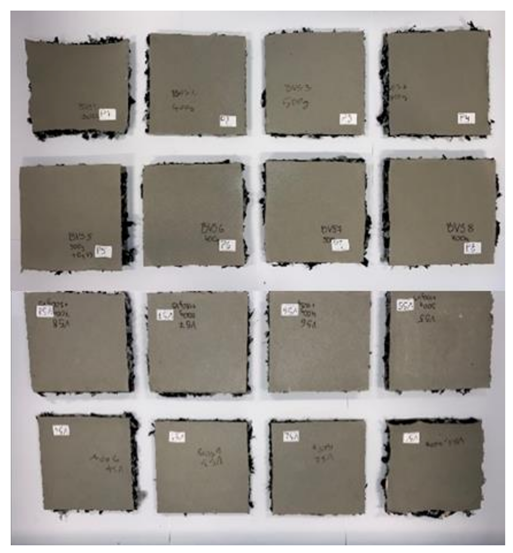
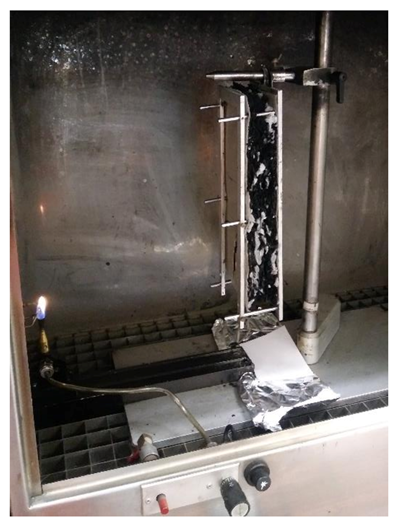
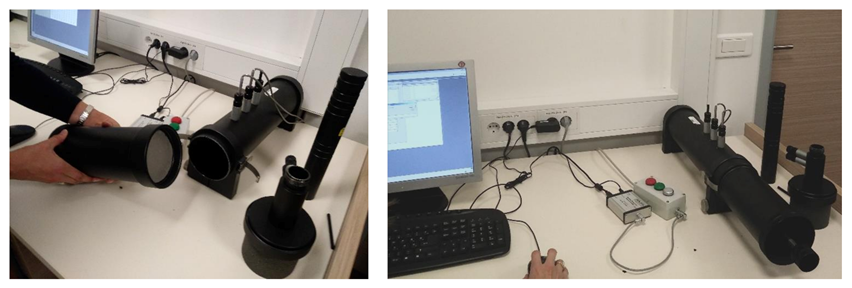
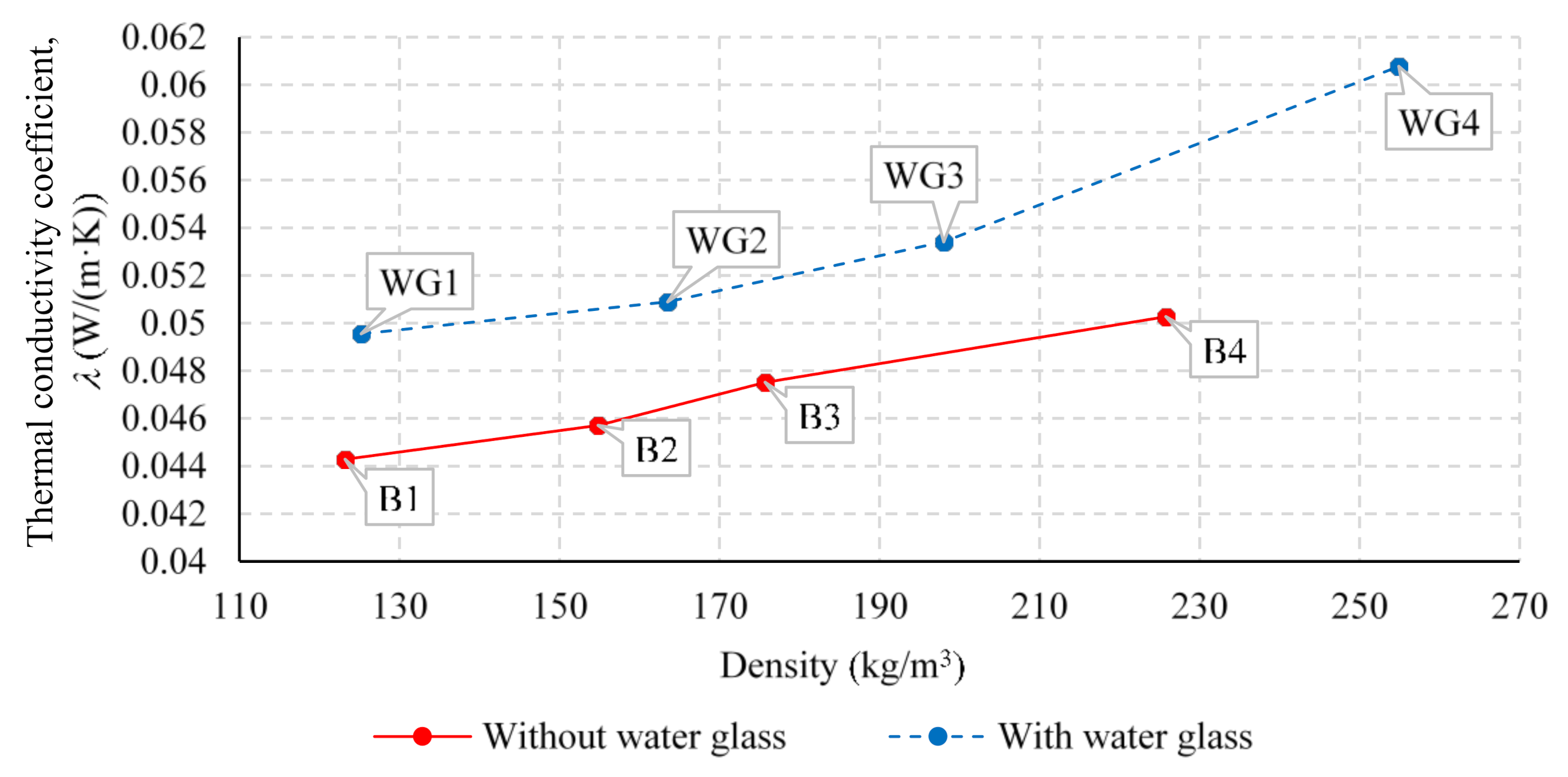
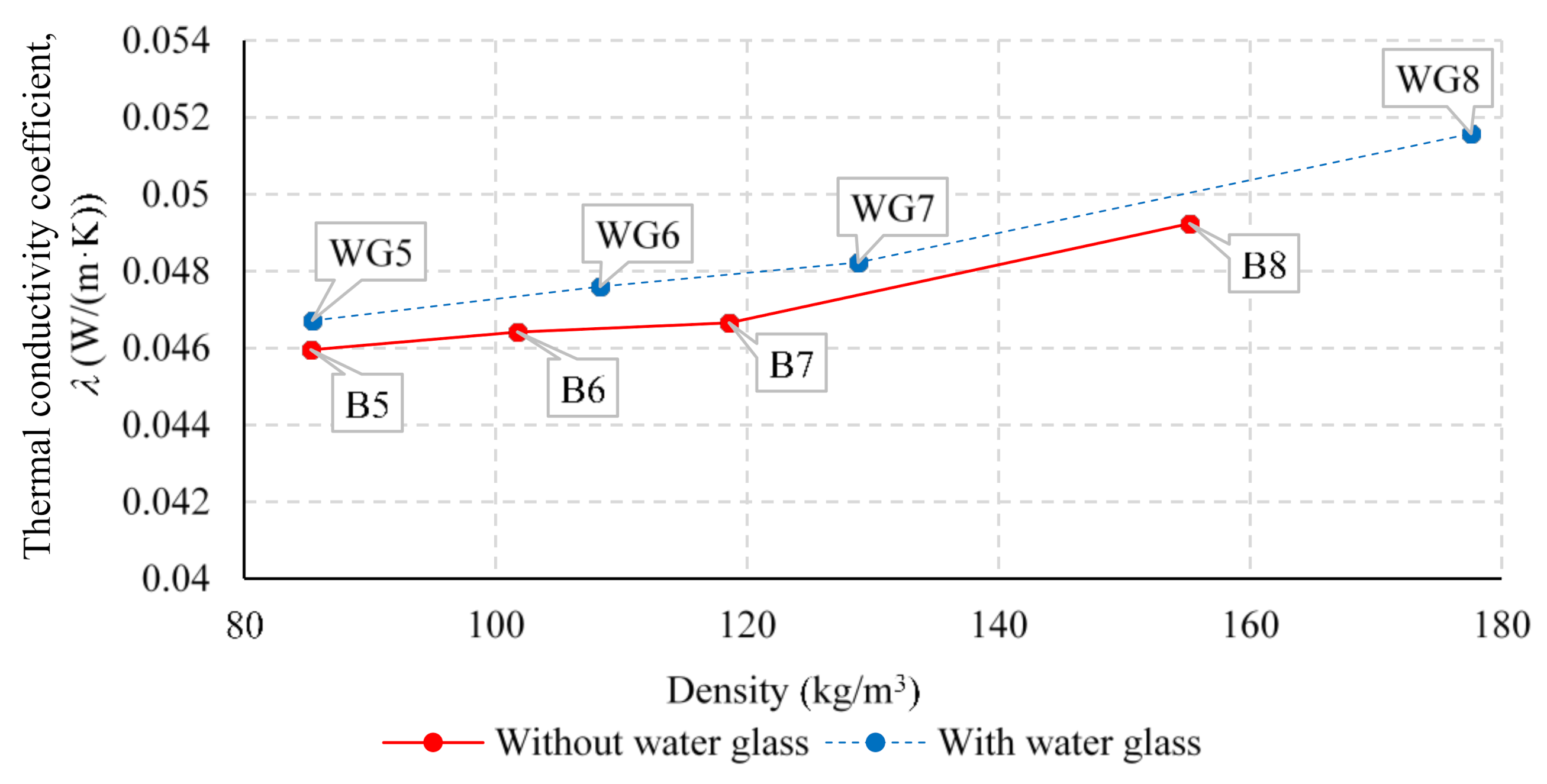

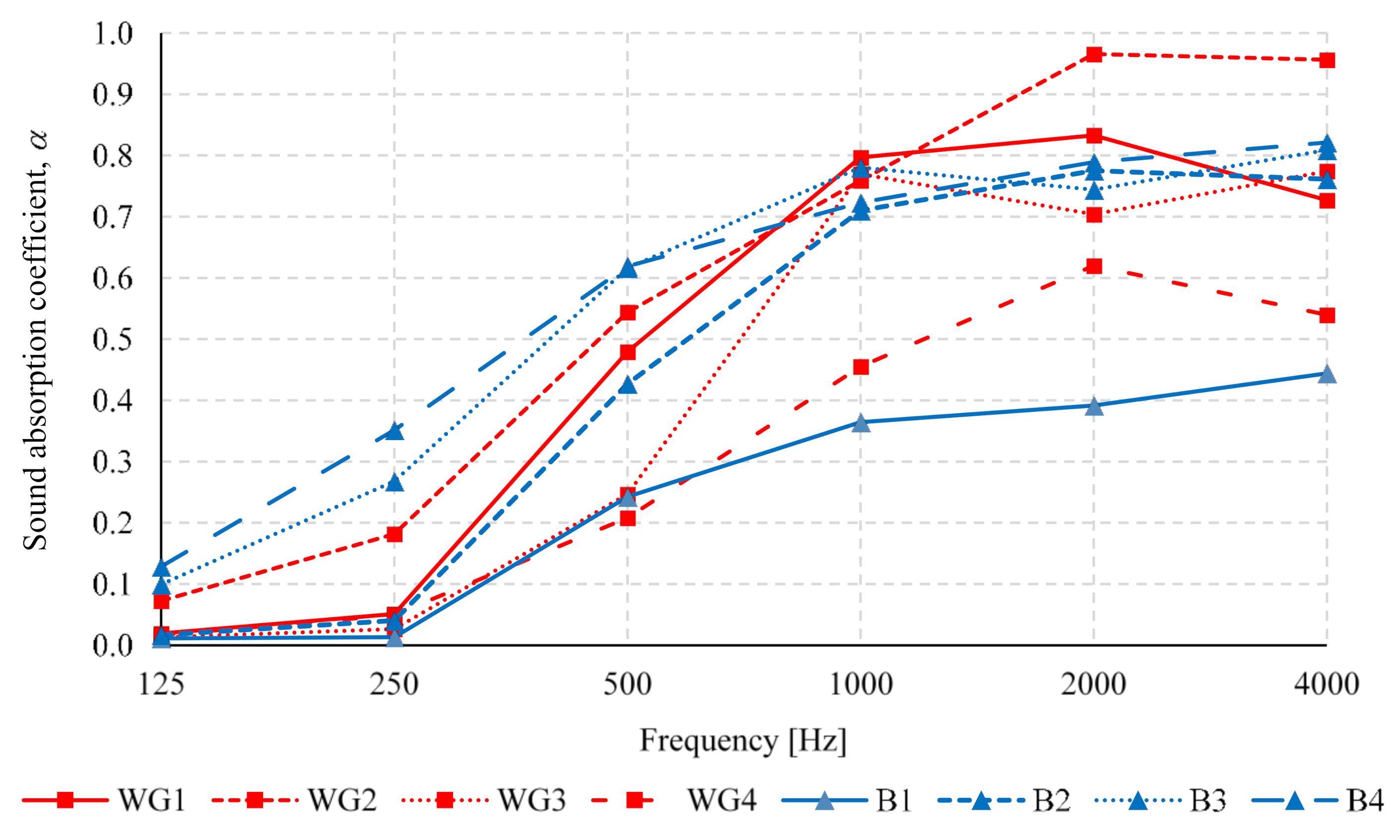
| Sample | Mass of the Waste (g) | Mass of the Water Glass (g) | Designed Thickness (cm) | Density (kg/m3) |
|---|---|---|---|---|
| B1 | 300 | 0 | 3 | 123 |
| B2 | 400 | 0 | 3 | 155 |
| B3 | 500 | 0 | 3 | 176 |
| B4 | 700 | 0 | 3 | 226 |
| B5 | 300 | 0 | 5 | 85 |
| B6 | 400 | 0 | 5 | 102 |
| B7 | 500 | 0 | 5 | 119 |
| B8 | 700 | 0 | 5 | 155 |
| WG1 | 300 | 100 | 3 | 125 |
| WG2 | 400 | 125 | 3 | 164 |
| WG3 | 500 | 150 | 3 | 198 |
| WG4 | 700 | 200 | 3 | 255 |
| WG5 | 300 | 100 | 5 | 85 |
| WG6 | 400 | 125 | 5 | 108 |
| WG7 | 500 | 150 | 5 | 129 |
| WG8 | 700 | 200 | 5 | 178 |
| Specimen | Ignition Time (s) | Flaming Droplet Time (s) | Flame Reaching the Reference Line Time (s) | Fire Extinguishing Time (s) |
|---|---|---|---|---|
| B1 | 2 | / | / | 40 |
| B2 | / | / | / | / |
| B3 | 15 | / | / | 32 |
| B4 | / | / | / | / |
| WG1 | 3 | 22 | / | 27 |
| WG2 | 10 | 55 | / | 60 |
| WG3 | 15 | / | / | 30 |
| WG4 | 13 | 30 | / | 69 |
| Specimen | Ignition Time (s) | Flaming Droplet Time (s) | Flame Reaching the Reference Line Time (s) | Fire Extinguishing Time (s) |
|---|---|---|---|---|
| B5 | 3 | 10 | / | 25 |
| B6 | 5 | / | / | 28 |
| B7 | 14 | 22 | / | 24 |
| B8 | / | / | / | / |
| WG5 | 5 | 10 | 90 | / |
| WG6 | 7 | 13 | 120 | / |
| WG7 | 5 | 15 | 130 | / |
| WG8 | 13 | 24 | / | 132 |
| Specimen | Density (kg/m3) | NRC |
|---|---|---|
| B1 | 123.2 | 0.25 |
| B2 | 154.8 | 0.50 |
| B3 | 175.7 | 0.66 |
| B4 | 225.8 | 0.66 |
| WG1 | 125.2 | 0.55 |
| WG2 | 163.5 | 0.60 |
| WG3 | 198 | 0.45 |
| WG4 | 254.9 | 0.35 |
| Specimen | Density (kg/m3) | Thermal Conductivity Coefficient, λ (W/(m·K)) | NRC | Source |
|---|---|---|---|---|
| B1–B8 | 85–226 | 0.044–0.05 | 0.25–0.66 | This study |
| WG1–WG8 | 85–255 | 0.047–0.061 | 0.35–0.55 | |
| Mixed textile waste | 50–500 | 0.034–0.08 | 43–80 | [9,11,13,15,43] |
| Polyester fibers impregnated with aerogel | 50–70 | 0.0255–0.0281 | / | [32] |
| Rockwool mat | 30–180 | 0.038–0.039 | 0.65 | [44,45] |
| Fiberglass mat | 14–80 | 0.032–0.038 | 0.65 | [44,45] |
| Extruded polystyrene | 33 | 0.035–0.038 | / | [45] |
| Polystyrene | 15–30 | 0.041 | 0.17 | [42,45] |
| Polyurethane foam | 15–80 | 0.025–0.040 | / | [45,46] |
Publisher’s Note: MDPI stays neutral with regard to jurisdictional claims in published maps and institutional affiliations. |
© 2021 by the authors. Licensee MDPI, Basel, Switzerland. This article is an open access article distributed under the terms and conditions of the Creative Commons Attribution (CC BY) license (https://creativecommons.org/licenses/by/4.0/).
Share and Cite
Antolinc, D.; Filipič, K.E. Recycling of Nonwoven Polyethylene Terephthalate Textile into Thermal and Acoustic Insulation for More Sustainable Buildings. Polymers 2021, 13, 3090. https://doi.org/10.3390/polym13183090
Antolinc D, Filipič KE. Recycling of Nonwoven Polyethylene Terephthalate Textile into Thermal and Acoustic Insulation for More Sustainable Buildings. Polymers. 2021; 13(18):3090. https://doi.org/10.3390/polym13183090
Chicago/Turabian StyleAntolinc, David, and Kristina Eleršič Filipič. 2021. "Recycling of Nonwoven Polyethylene Terephthalate Textile into Thermal and Acoustic Insulation for More Sustainable Buildings" Polymers 13, no. 18: 3090. https://doi.org/10.3390/polym13183090
APA StyleAntolinc, D., & Filipič, K. E. (2021). Recycling of Nonwoven Polyethylene Terephthalate Textile into Thermal and Acoustic Insulation for More Sustainable Buildings. Polymers, 13(18), 3090. https://doi.org/10.3390/polym13183090






